Abstract
To maintain a competitive edge, businesses must be highly adaptive and resilient. The COVID-19 coronavirus pandemic has dramatically impacted the organizational practices of Saudi Arabian companies. One of the main effects has been to move employees to work from home virtually, which has raised legitimate questions about finding better management and productivity strategies. It was clear that relying only on basic managerial skills in the new environment was impossible, as it had the potential to lead to organizational crisis and loss of trust. At the same time, it was essential to create a new ethic that was relevant to remote employees, combining work responsibilities and home environments. This research paper consistently answered the questions of e-leadership and remote working. The critical research tools were a literature review and two case studies of STC and Mobily telecommunications companies present in the Saudi Arabian market. It was shown that each organization’s experience is different, and while STC focused more on creating a supportive work environment for employees and providing training, including for executives, Mobily management sought to intensify their commitment to innovation and improve their own designs. Both companies showed improved profitability for 2020, but the paper emphasized that this metric cannot be associated solely with moving employees online, although general trends are noticeable. Thus, the research paper served as an excellent summary of current trends related to e-leadership aspects.
Introduction
It would be erroneous to claim that the field of modern business is characterized by stability and conservatism. On the contrary, in an ever-changing global marketplace in response to increasing social demands, businesses must be sufficiently adaptive and adaptable to the environment to maintain competitive advantage and vitality. Of primary importance for realizing these performance criteria is the recognition by business leaders of dynamic transformation and a deep commitment to change. Consequently, only a leader who can anticipate and manage change has the potential to maintain high performance in the company.
At the same time, it is crucial to understand that dynamic market fluctuations cannot necessarily be predicted in advance. In fact, fluctuations such as aggregate demand, industry leadership, or technological advancement trends are generally well predicted by analysts (Alshammari, 2020). However, some global changes, in particular the COVID-19 pandemic, can suddenly change the market structure in all countries, slowing down business processes and disrupting entire supply chains. In this case, influential leaders are expected to implement professional competencies to manage the current changes and the ability to adapt to the business promptly.
This research paper conducted an in-depth study of the aspects and opportunities that have become relevant to today’s Saudi Arabian companies in the COVID-19 environment. In particular, it is recognized that some of the main effects of the pandemic have been the demands of social distancing and isolation, expressed including through the need for employees to work remotely (Sattar et al., 2020). In an effort to comply with sanitation and epidemiological protocols, most local companies have moved a large percentage of employees online. Since it is taken into account that the lack of well-established mechanisms for managing remote employees and creating an optimal culture for their interaction can lead to a severe enterprise crisis, finding better preventive management strategies is a priority. This research paper had an academic focus on an extensive parallel study of the literature covering effective e-leadership and communication opportunities. In addition, the work examined the experiences of two Saudi Arabian companies in the field of telecommunications, KSA and Mobily. Consequently, this paper is a relevant and valuable contribution, as it not only summarizes current research but also critically evaluates the possibilities of its applicability, subject to the end of the COVID-19 pandemic.
The Objective of the Paper
Thus, recognizing the priority of the problems posed in the previous part, this research paper attempts to qualitatively answer the questions of e-leadership and remote communication in the context of the effects of the global COVID-19 pandemic. The Saudi Arabian labor market, represented by two large enterprises, STC and Mobily, was chosen to concretize the study. Consequently, the generalized purpose of the research paper was to critically analyze the trends and opportunities of e-leadership and remote working through the examples of two Arab companies.
Importance of the Research Project
It is of profound importance for academic papers to recognize the importance that the material has to the academic community. This idea was incorporated in the development of the objectives and design of the research paper’s structure, and therefore the value of this paper was determined by several aspects at once. First and foremost, the paper created an excellent synthesis of available literature and journalistic sources, and reports covering the pandemic’s impact on Saudi Arabia’s work practices. Consequently, upon completion of their reading, the attentive reader could gain ample helpful information on the current issues. Second, most academics recognized that the concepts of digital leadership and effective measures of remote work were not fully developed due to a previously lacking need (Contreras, Baykal, and Abid, 2020). Consequently, this paper was notable for the novelty of the proposed solutions. Finally, a fundamental significance for this work was the recognition that even after the restrictive measures initiated by COVID-19 are over, e-leadership and remote working trends will continue to be relevant, meaning that this work was not ad hoc, a one-off in nature. Taken all together, this research paper can be identified as an academically significant, valuable resource for students, professors, and other interested parties.
Methodology and Hypotheses of the Research Project
This study’s central idea was to use the case study of two large Arab companies as models to examine the trends and possibilities of remote leadership and work. It should be recognized that case studies are qualitatively different from other methodological approaches because they do not have significant constraints and requirements for implementation (Meyer, 2001). Nevertheless, the absence of these criteria has allowed the current problem to be viewed more broadly, with a combination of qualitative and quantitative analyses. In doing so, case studies have the properties of longitudinal, contextual, and scalability, which were valuable features within the framework of the issue under investigation.
As emphasized earlier, the case studies were a vital component of this academic work. The project methodology was based on using available data from two companies in the Saudi Arabian market, STC and Mobily. As shown by Meyer (2001), selecting two cases at once is more preferable because it inhibits the possibility of selection error and reduces the effects of researcher bias. In addition, the use of two case studies allowed for qualitative comparative analysis, highlighting differences and similarities in the two Arab companies, and thus this strategy was most desirable.
The next phase of the research study was the selection of case studies that would be of increased interest to this paper. Given the Saudi Arabian market’s dynamic nature, it was decided to focus on the companies that best reflect adherence to global demands, high technology, and innovation. This particularization was supported by the view that more conservative companies were less likely to start optimizing e-leadership and remote working processes, and therefore the highest quality results for the Saudi industry could only be obtained by analyzing progressive companies. So two Arab companies were chosen, STC and Mobily, which carry out their professional activities in telecommunications, customer service, and mobile and Internet services. The two-valued critical analysis design, implemented through the evaluation of both e-leadership and remote employee work in general, further reduced the undesirable effects of author bias and prejudice.
The two case studies’ document collection procedure was implemented by independently searching for any helpful information pertaining to the concepts under study. The principal platforms of the search were the official websites of the enterprises, which provide open access to the published data, journalistic articles, and scientific sources, which allowed a conceptual evaluation of the collected material. It should be acknowledged that the author of this research work was not part of the corporate networks of the mentioned enterprises, and therefore any internal information could be obtained only through a deeper study of available sources. Simultaneously, conducting the survey was not a good idea due to the limited resources of research time combined with the problems of finding employees and managers (informants) who fully represent the companies’ image.
As mentioned earlier, the present work used the methodology of a literature review of sources to search for evidence or refutation of the study’s conceptual framework. The strategy of selecting scientific materials was based on the use of syntactic rules, among which the need for the terms “COVID-19”, “pandemic,” or “isolation” to be present in the body of work on remote work and digital leadership. It seems evident that there was a time limit for such works, so the age of the sources used most often did not exceed two years. All materials were found through the online platform Google Scholar, configured according to the above criteria: a total of 24 articles were initially selected, which were subsequently subjected to secondary testing. Thus, if a reading of the materials showed that the article had little relevance to the task at hand and could not answer the objectives qualitatively, its further use was rejected.
As a result, the collected materials allowed for an evaluative analysis of the areas under study for each of the two companies separately and a comparative analysis for both of them, which is reflected in detail in the following sections of the paper. Such research was focused primarily on finding answers for the working hypotheses. Thus, the first hypothesis was formulated as that the remote working phenomenon tends to increase employee productivity and productivity by reducing time spent on inefficient communication and distractions, which has a positive effect on profit growth. More specifically, it was hypothesized that the emphasis on intensifying employees’ hands-on functionality was initiated by the reduction in low-efficiency communication, employee isolation, and lack of regulated breaks. The second working hypothesis was the assumption that successful implementation of remote leadership combined with basic supervisory skills required mastery of online moderation rules, computer literacy, and a body of new ethics. Thus, the central part of this paper aimed to test the above hypotheses critically.
Literature Review
The market system’s ability to signal promptly in response to rapidly changing environmental conditions determines the guiding function. Thus, a scenario in which the market turns out to be highly conservative and closed to influence seems implausible since the exchange of values and information characterizes the properties of a thriving market. Simultaneously, it should be clearly understood that the key driving force of the market system is competition, the competent management of which allows enterprises to design their development plans even under external pressure. Consequently, the most proactive and developed companies have advantages because they can better cope with environmental fluctuations and manage change.
To survive in a dynamic marketplace, they must have the properties of increased adaptability and resilience. Rigid management plans and designing programmable solutions for several years ahead are no longer relevant for today’s business environment because any qualitative changes in the market can disrupt organizational plans. So, change is forcing companies to shift their focus from anticipating fluctuations to methods of building a structure that will show the ability to embrace transformation and turn general instability to their advantage. To do this, each company must have a high degree of flexibility to implement operational changes in response to pressures (Alshammari, 2020). At the same time, company managers must be mobile and proactive enough to be able to make critical decisions in a timely and effective manner. Finally, to increase resilience, companies need to constantly assess the risks and threats from the measures taken associated with the market dynamics. Consequently, it is appropriate to conclude that companies need to increase their level of adaptability and agility to remain competitive in today’s business environment.
A unique role in the context of the discussed aspects is the recognition of the fact that not all market fluctuations can be predicted in advance. In particular, the global pandemic caused by the new coronavirus infection COVID-19 was a factor against which preventive action could not be developed in advance (Fana, Pérez, and Fernández-Macías, 2020). It has been shown that the Saudi Arabian market has been hit hard by the pandemic, as there has been a noticeable overall decline of from 21 to 40 percent in business revenues in the first quarter of 2020 (Puri-Mirza, 2020). In addition, the sudden incarnation of restrictive measures caused an imbalance in aggregate supply and demand, leaving many businesses in liquidation (Abu Nasr, 2020). These effects were primarily due to companies’ compulsion to close offices in the face of the development of social distancing and isolation measures. Company executives, in order not to lose profits and to keep businesses running even when employees were physically absent from their workplaces, decided to deploy remote working practices aimed at online corporate interaction.
In the context of the discussed strategy of transition to a virtual format of work obligations, the issue of ensuring the necessary and sufficient measures to achieve optimal working conditions has become particularly acute. It is well known that the overall productivity of employees, thus the enterprise’s productivity, is composed of personal motivation, belief in the value, commensurate compensation, and, equally important, practical leadership activities (Sutrisno and Sunarsi, 2019). Thus, it was a priority in a remote work environment to develop management strategies that showed high performance and reliability. It is fair to acknowledge that digital leadership is not an entirely new phenomenon to the marketplace, and a retrospective analysis of the citation index shows the presence of case studies over the past twenty years (Figure 1).
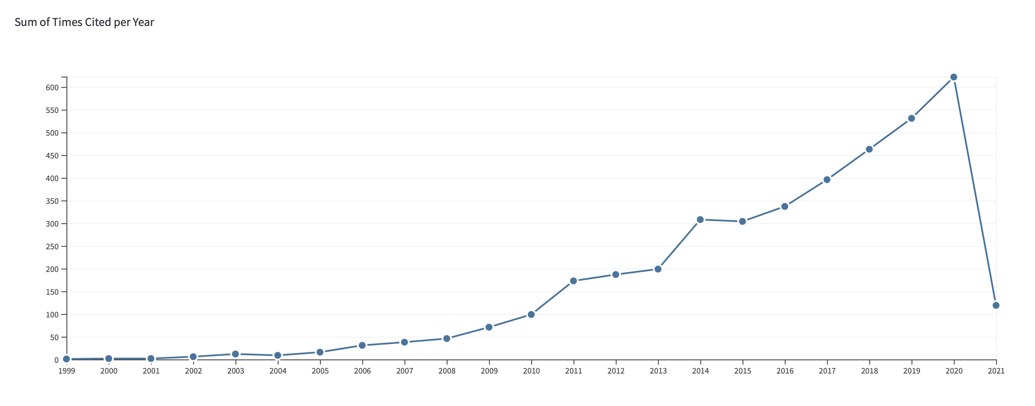
As can be seen from the chronogram, the broadest interest in e-leadership research has only become relevant recently. Nevertheless, the intensification of the number of publications does not mean that the quality of the data collected has improved. Thus, Contreras, Baykal, and Abid (2020) noted that extensive and valuable data on the issue of digital leadership in the Arab labor market is lacking. To put it differently, to date, researchers have only been able to refer to general, conceptual information that overviews the phenomenon of remote leadership and work or to sporadic profile studies.
Consequently, the emergence of e-leadership is difficult to unequivocally link to the emergence of the COVID-19 pandemic because, as previously recognized, scientific research on these topics was already relevant. Without viewing the pandemic as a central driving force, Alfehaid and Mohamed (2019) interpreted the source of the high popularity of this format of corporate interaction in the Arab market as a natural response to the emergence of global companies since the late 1990s. To curate work processes among international employees, e-leadership was a major strategic decision. It allowed to unite and strengthen the experience of small-interacting virtual workers. A natural response to the proliferation of remote leadership was to attempt to explore critical skills and potential threats a supervisor might face during work practices. Indeed, the fundamental traits of a traditional leader, such as initiative, risk-taking, and management abilities, should be retained, but an effective leader should not rely solely on using them in an attempt to achieve better results. In light of the issue at hand, the work of Cahyadi and Magda (2021), which assessed the most critical areas of personal development for the modern remote leader, attracted particular attention. More specifically, they showed that deep learning of the basics of digital culture combined with increasing levels of computer competencies allows a leader to demonstrate the same high organizational effectiveness. Moreover, the authors additionally stressed the necessity of striving for change and increasing the culture of innovativeness in the working team, which seem to be undeniable needs for a manager who decided to use a new format of interaction with subordinates.
The studies mentioned above made a profound contribution to the conceptual development of e-leadership, but the relevant topic for discussion was still the analysis of the threats a manager may face. Since the virtual environment for communication is a relatively new space for Saudi office workers, there is no doubt that the primary risks include the presence of technical errors in the management organization. Communication delays, communication malfunctions, and the difficulty of structuring the team can significantly undermine the leader’s legitimacy (Alfehaid and Mohamed, 2019). In turn, the consequences of a lack of complete confidence in workgroup leaders are disruptions and delays in assigned tasks and inhibiting the development of formative influence. An employee who lacks confidence in their own mentor cannot perform quality work and shows low interest in achieving overall success (Breevaart and Zacher, 2019). Consequently, there is an organizational demand for quality control of the remote leader’s work. A qualitative-quantitative study conducted in the Saudi Arabian market has shown which criteria for evaluating e-leadership are most relevant to the agenda (Naveed et al., 2017). In particular, reliable performance expertise must rely on a systematic and technological approach to measurement. Based on the findings, it can be assumed that the updated management format’s general impressions and performance dynamics can be gathered through a periodic online survey among subordinate employees.
Consequently, this literature review results allow summarizing that e-leadership is a relatively new trend in the corporate agenda, but its emergence does not involve a pandemic. Nevertheless, with the severe constraints of Arab business, most companies have been forced to adapt their operations to the online mode, and digital management has become a vital issue. This operational transformation of business processes has been shown to have favorable labor productivity results, at least in the short term (Zawya, 2020). The e-leader must possess a number of qualitatively new traits, among them a digital culture, computer literacy, and a commitment to innovation, in addition to the traditional basis of the offline leader. Finally, a systematic and technological assessment of the renewed management approach’s effectiveness must be provided to detect weaknesses and vulnerabilities promptly.
Case Study: STC
One of the most progressive and dynamic market industries in Saudi Arabia is telecommunications. Domestic businesses generally aspire to leadership positions in the competitive race for technology, with some companies deservedly gaining international exposure. This is also true for STC, a notable organization that offers mobile, Internet, and other remote communication methods to Arab people and businesses. To form a complete organizational image of STC, it is appropriate to review its key metrics. For example, the telecommunications company’s total revenue for 2019 was $14.50 billion, with solid asset growth over the three years from 2017 to 2019 (Figure 2, Figure 3). By now, STC has about 20,000 employees, represented by both Saudi natives and expatriates. STC’s central competitors are Etisalat Group, Ooredoo Q. P. S. C., and GTH S. A. E.
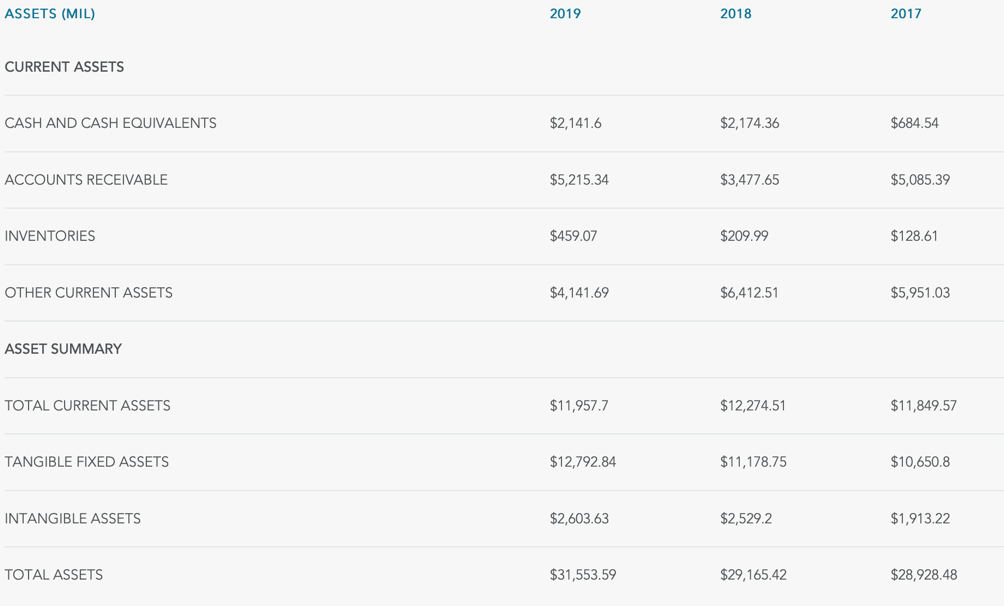
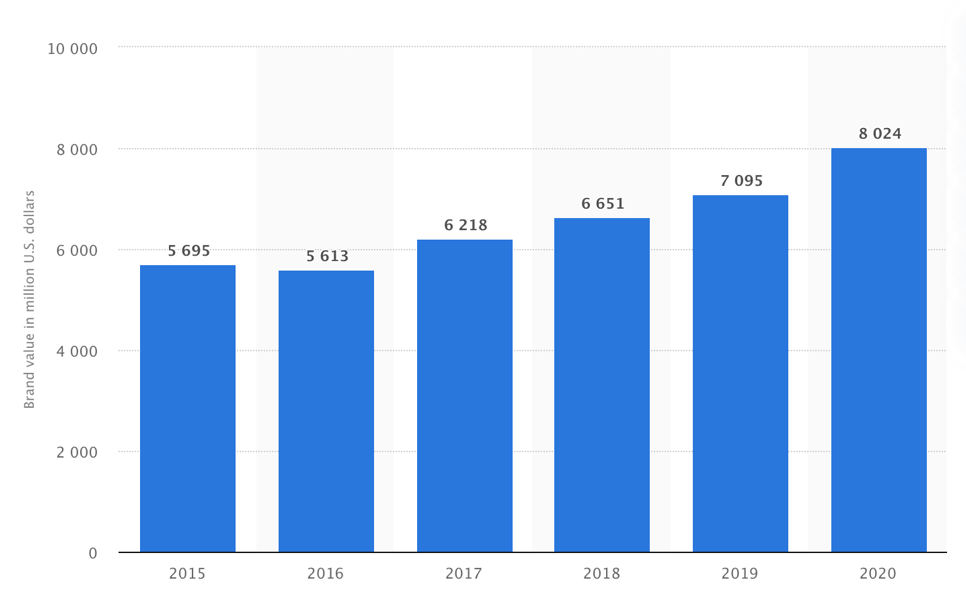
It is fair to say that the need for virtual employee management predates the pandemic when the company made decisions to expand in the Gulf market. Nevertheless, even as severe coronavirus restrictions were being implemented, STC continued to show profit and spread its influence on nearby countries. In particular, in the second half of 2020, CEO Al Nasser claimed tremendous growth for the company, both in terms of organizational staffing and in the context of customer usage (Saba, 2020). STC has entered into several beneficial agreements with the administrations of Dubai, Bahrain, and Kuwait to obtain new permits to expand into local markets. In addition, Al Nasser has not ruled out the possibility of development in India, Egypt, Pakistan, and the Philippines, if it proves profitable.
Consequently, STC characterizes a very progressive telecommunications company of a modern Arab country, which means that its testing in the context of e-leadership is an effective strategy. Simultaneously, it seems natural for the firm’s primary professional focus to develop virtual employee interaction systems, which was only catalyzed by the need for strict social isolation. For example, back in 2017, management implemented a remote work reform whereby each employee had the corporate right to work about three days a month remotely (STC, 2017). This decision was justified by the need to improve operational flexibility and develop a digital culture of employees. During the first wave of the coronavirus, the number of STC employees switched to a remote work format exceeded three thousand, with the duration of such a trial already being 14 days (STC, 2017). From a numerical perspective, the growth in the number of remote employees in 2020 was +1,128%, and at least 3,500 online meetings are realized every day through the mySTC corporate platform. In this regard, it seems apparent that e-leadership cannot be ignored in such an advanced telecommunications structure. Although STC does not disclose its updated e-leadership etiquette details, some functional patterns can be discerned from the company’s official news and announcements.
First and foremost, STC is not looking to bring employees back to physical offices because coronavirus restrictions have not yet been fully lifted. Realizing the importance of supporting employees virtually, mySTC executives decided to keep the distance for the new school year because “with the start of the new school year, it would be difficult for working parents to work from the office” (TR, 2020). This measure demonstrates a high degree of concern for employee well-being, which leads to the legitimacy of e-leaders. Simultaneously, the company has provided employees with complete instructions for dealing with any technical or moral issues related to the operational transformation. The new remote work etiquette was detailed on the corporate website, and its most intriguing rules included the need to be constantly in touch, the importance of constant communication, the need to create breaks, and designing a safe, comfortable work environment (Barrett, 2020). In addition, although the link between employee remoteness and an overall increase in efficiency has already been shown, a comparative analysis of company financial statements will provide practical evidence of.
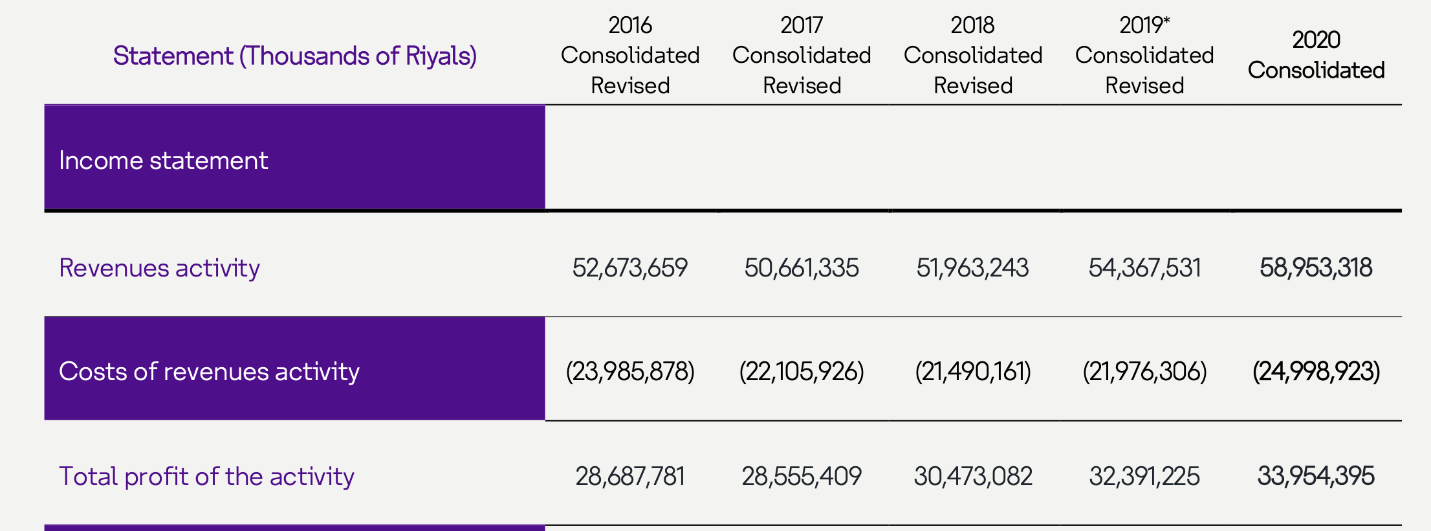
Case Study: Mobily
Another key figure in Saudi Arabia’s telecommunications industry is Mobily, a large company founded in 2004. The firm provides fixed and cell phone services, Internet connectivity to customers and develops the region’s technology industry. As of 2020, Mobily had total revenues of $3.75 billion, although the level of total assets was down 25.7 percent (Figure 5). An increase in accounts payable is also noticeable, which may collectively indicate a difficult financial period for Mobily. In addition, a historical analysis of the company’s operations shows that the firm’s management has been focused on expansion since its inception, so Mobily’s presence is characteristic of both the North African and Gulf regions.
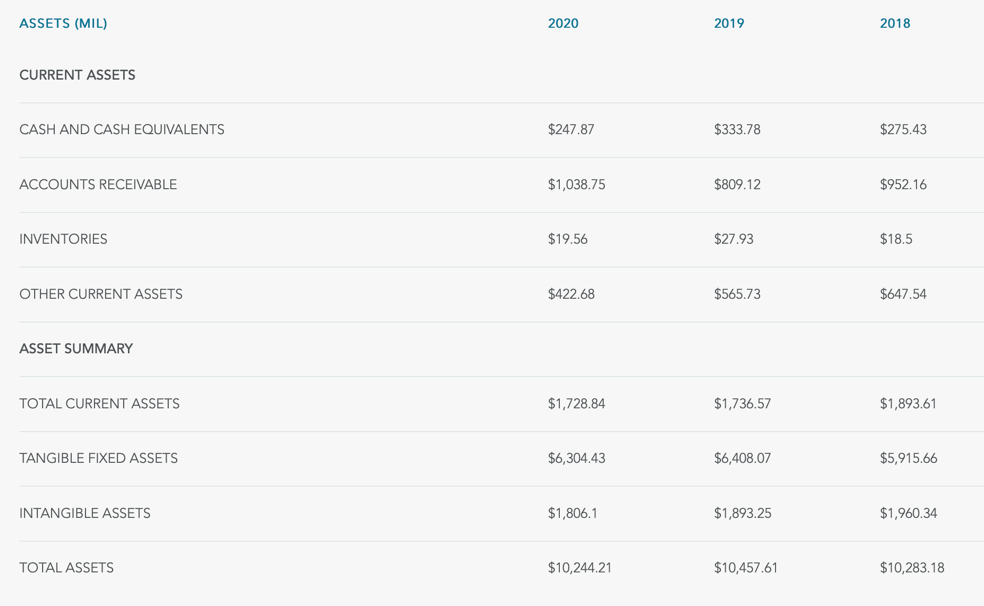
Similar to other companies, Mobily is interested in its employees’ safety and the full implementation of government health regulations in a pandemic. Specifically, after the issuance of a form regulation, all of the company’s operational processes were moved online in just 48 hours (Mobily, 2020). Furthermore, throughout the complete isolation, the company’s key departments continued to work with customers around the clock, which shows the effortless adaptability of Mobily’s structure. In addition, to improve remote employees’ competencies, management launched training programs to perform work tasks from home. In turn, this initiated the development of technological solutions for employee interaction, which translated into the creation of a corporate holistic digital community and instant speech recognition tools. Acts similar to these demonstrate the company executives’ concern for employee comfort and a deep commitment to innovation. Additionally, it should be recognized that the company has made incredible progress in financial growth, reporting a record 2412% increase in net income (Mobily, 2020). However, associating this growth only with the ability to switch to a remote working format is incorrect, as the primary source of profit was the focus on high-income customers. Otherwise, the company did not publish any consolidated news about the effectiveness of remote work or the rules that leaders use when interacting in an online environment.
Comparison Between Them
Even a cursory analysis of the previous two sections allows identifying that there are differences between the activities of STC and Mobily in the context of the pandemic. First of all, it should be recognized that STC is a Saudi Arabian firm, whereas Mobily began to be present in the local market only as part of an expansion program. Thus, STC initially had a competitive advantage, realized through a better understanding of the culture, environment, and characteristics of the population. Apparently, this was the reason why STC took more care of its employees during transitional periods, making their comfort and safety a priority. However, Mobily also responded to a government requirement to move employees online, but this news was not advertised by management with as much pride as it was at STC.
In addition, there were noticeable differences in the emphasis the companies placed on the COVID-19 periods. More specifically, the STC was focused on creating a supportive work environment, so it developed its mySTC platform and worked extensively to train employees and leaders in computer interaction skills. Simultaneously, the primary vector of Mobily’s development during this period was innovative development, realized through the conclusion of several key contracts, the development of the 5G network, and improvements in speech recognition tools. Most likely, this divergence can be justified by Mobily management’s desire to first catch up with the technological development of STC, which launched the described tools a few years earlier.
Conclusion
In conclusion, this research paper raised pressing issues of e-leadership and remote working in the COVID-19 pandemic inherent in the Saudi Arabian labor market. Case studies, namely the telecommunication industry represented by STC and Mobily, were chosen as research tools. An alternative means of finding answers to the questions was a literature review of sources. It is essential to see that not all working hypotheses were fully confirmed. For example, from the analyses of work and financial reports of the two companies, it was shown that labor productivity with the remote format of work likely increased, but there is still no unequivocal answer to this question. Additional directions of organizational development could have caused the increase in profits, but the fact that profits have not declined may indirectly indicate the effectiveness of the virtual format. In addition, it has been shown that e-leaders must adopt new competencies to improve practices, including computer literacy and digital etiquette. STC has released a set of guidelines for employees and leaders that perfectly summarizes the new virtual work ethic rules.
Given the findings, it is appropriate to create a list of recommendations for managers and employees who decide to use virtual collaboration. First of all, one should develop one’s computer literacy to minimize technical errors and stagnation. Second, each employee should be constantly connected during working hours, not distracted by home tasks. Third, employees should create breaks between work sessions. Fourth, leaders must develop formative influence in a way that earns the trust and acceptance of subordinates. Finally, it is crucial to structure interactions online thoroughly.
Reference List
Abu Nasr, W. (2020) Kingdom of Saudi Arabia. Web.
Alfehaid, L. and Mohamed, E.E. (2019) ‘Understanding the influence of E-leadership on Virtual Team Performance Empirical Study,’ International Journal of Business and Social Science, 5, pp. 21-36.
Alshammari, A. (2020) ‘Factors influencing the organizational culture, resource management and effective management in large KSA industries,’ International Journal of Management, 11(10), pp. 159-177.
Barrett, M. (2020) Tips for working from home. Web.
Breevaart, K. and Zacher, H. (2019) ‘Main and interactive effects of weekly transformational and laissez‐faire leadership on followers’ trust in the leader and leader effectiveness,’ Journal of Occupational and Organizational Psychology, 92(2), pp. 384-409.
Cahyadi, A. and Magda, R. (2021) ‘Digital leadership in the economies of the G20 countries: a secondary research,’ Economies, 9(1), p. 32-47.
Contreras, F., Baykal, E. and Abid, G. (2020) ‘E-leadership and teleworking in times of COVID-19 and beyond: what we know and where do we go,’ Frontiers in Psychology, 11, pp. 3484-3501.
DB (2021) Etihad Etisalat Company. Web.
Fana, M., Pérez, S.T. and Fernández-Macías, E. (2020) ‘Employment impact of Covid-19 crisis: from short term effects to long terms prospects,’ Journal of Industrial and Business Economics, 47(3), pp. 391-410.
Meyer, C.B. (2001) ‘A case in case study methodology,’ Field Methods, 13(4), pp. 329-352.
Mobily (2020) Annual report. Web.
Naveed, Q.N., Muhammad, A., Sanober, S., Qureshi, M.R.N. and Shah, A. (2017) ‘A mixed method study for investigating critical success factors (CSFs) of e-learning in Saudi Arabian universities,’ Methods, 8(5), pp. 171-178.
Puri-Mirza, A. Opinion on the impact of COVID-19 on business revenue Saudi Arabia Q1 2020. Web.
Saba, Y. (2020) Saudi Telecom’s digital payments business plans Gulf expansion. Web.
Sattar, M.F., Khanum, S., Nawaz, A., Ashfaq, M.M., Khan, M.A., Jawad, M. and Ullah, W. (2020) ‘COVID-19 global, pandemic impact on world economy,’ Technium Social Science Journal, 11, pp. 165-179.
Saudi Telecom Company (2021) Web.
SRD. STC’s brand value 2015-2020. Web.
STC (2017) STC launches a new permanent telecommuting policy. Web.
STC (2020) 3,000 employees are working remotely during the next two weeks. Web.
STC (2020) Annual report. Web.
Sutrisno, S. and Sunarsi, D. (2019) ‘The effect of work motivation and discipline on employee productivity at PT,’ Anugerah Agung in Jakarta. Jurnal Ad’ministrare, 6(2), pp. 187-196.
TR (2020) STC announces new internal policy allowing parents to work remotely. Web.
Zawya (2020) Remote working ‘more productive.’ Web.